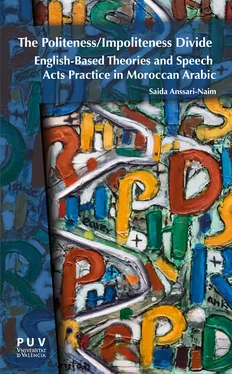The use of formulaic language such as jokes or swearing by non-native speakers is not always considered as an appropriate means of relating to the ‘native group’. Native speakers might interpret such uses of the idiosyncratic facets of their language by non-native speakers as invasive, and hence might reject them; at other times such uses might be considered strange, causing surprise and perhaps disapproval; or, on the contrary, they might be seen as entertaining and thus earn approval. On the other hand, non-native speakers might detach themselves from the linguistic norms of the native group and underline their identity through the use of their own communicative repertoire, a situation which probably derives from the value non-native speakers place on their own culture and language in an ‘alien’ setting. Accordingly, it may be observed that members of a non-native group with a cultural orientation towards negative politeness deliberately adopt such a cultural pattern in their communication with members of a culture oriented towards positive politeness, this as a means of conserving their own idiosyncrasy despite the likely risk of miscommunication between interactants.
Comments on things ‘going wrong’ in interaction usually refer to communication between members of different cultures and, most frequently, different languages. There is a considerable research literature on mismatch talk and its consequences, that is, the association between breaks in communication and differences in the attribution of meaning to linguistic forms or silence in different cultures (Cf. Thomas 1983, Saville-Troike 1985, Tannen 1986, Ting-Toomey 1988, Sarangi and Slembrouck 1991, Tyler 1995, Roberts 1996, among others). Although the real difficulties that participants in intercultural encounters frequently experience cannot be ignored, the absence of problems of meaning exchange among interactants of the ‘same culture’ in no way indicates an absence of miscommunication at a deeper level. As Habermas (1970) maintains in his arguments on ‘pseudo-communication’, the notion of sharing the same linguistic code is an erroneous belief, in as much as it speciously attributes simplicity and ordinariness to communication. Such a point of view is reflected in a comparative study by Herbert (1990) on variations in the use of compliments by South Africans and North Americans, where both of these groups have the same L1.
3.2. Politeness as a universal variable in cross-cultural communication
The attention within pragmatics towards politeness theory over recent decades has resulted in a vast and varied literature. Indeed, linguistic politeness theory can almost be considered an independent branch of pragmatics; more specifically, it constitutes a social approach to pragmatics, rather than a cognitive approach (such as in relevance theory). Thomas (1995) enumerates a variety of sets of phenomena for which theories of politeness have been used: politeness as (1) a real-world goal; (2) as deference; (3) as register; (4) as a surface level phenomenon; (5) as an illocutionary phenomenon (1995: 149). The approach to politeness discussed in the present chapter falls within the fifth sub-class. However, even in this subset, various areas can be identified. Thus, Thomas (1995) following Fraser (1990) has gone on to distinguish between:
1. Politeness explained in terms of principles and maxims (Leech 1983)
2. Politeness and the management of face (Brown and Levinson 1987)
3. Politeness viewed as a conversational contract (Fraser 1990)
As noted above, in recent decades politeness has been one of the central areas of work in pragmatics (cf. for example, Thomas 1983, Blum-Kulka 1987, 1992, Sifianou 1992, Kienpointner 1997, Watts, Ide and Ehlich 1992, Eelen 2001, Bargiela-Chiappini and Harris 2006). However, no consensus appears to exist in terms of how to define politeness; “politeness will always be a slippery and ultimately indefinable quality of interaction which is subject to change through time and across cultural space. There is, in other words, no stable referent indexed by the lexeme polite” (Watts, Ide and Ehlich 1992: xiii). The perennial discussion over how to define politeness is still a matter of contention. In what follows, I will offer an overview of the different trends and approaches.
Politeness as face-saving strategy : Brown and Levinson’s (1987) theory is based on the existence of a Model Person who is rational and is endowed with face. Rationality denotes that the Model Person is “endowed with… a precisely defined mode of reasoning from ends to the means that will achieve those ends” (Brown & Levinson, 1987: 63). In addition, face is to be understood in terms of Goffman’s definition of the term as “the positive social value a person effectively claims for himself by the line others assume he has taken during a particular contact” (Goffman 1955: 213). Brown and Levinson define face as the “public self-image that every member wants to claim for himself” (Brown and Levinson 1978: 66). Then, they divide face into two different, but related aspects, namely positive and negative face which are to be understood in terms of wants that every person knows every other person has (Brown and Levinson 1987: 67). Positive face denotes the desire to be appreciated and approved by others, whereas negative face concerns a person’s desire to be unimpeded and free from imposition (Tracy 1990: 210).
Brown and Levinson also classified verbal or non-verbal acts, which contradict or “run contrary to the face wants of the addressee and/or speaker” as Face-Threatening-Acts (FTA) (1987: 70). Requests for instance, are considered as FTAs to the hearer’s (H) negative face in so far that the speaker (S) is impeding H by asking H to do what S wants and not what H wants. On the other hand, any “contradiction or expression of disagreement, which means the speaker thinks that there is something wrong with an opinion held by the hearer” is a FTA to H’s positive face. There are also acts that threaten both positive and negative face of the H, as is the case when H complies with S’s wants but not necessarily his or her own” (Fasold 1990: 161).
Some other acts are liable to affect S’s positive face, such as expressing thanks, excuses, acceptance of offers and apologies, acceptance of compliments, confessions, etc.; meanwhile, others affect S’s negative face, as with the acceptance of compliments, confessions, admission of guilt, or apologies where S recognises that his or her act contradicts H’s expectations. According to Brown and Levinson’s politeness hypothesis, MP (a Model person) would resort to different strategies to keep his/her face intact and at the same time to reduce the possibility of damaging the positive or negative face of H.
Brown and Levinson grouped these politeness strategies that speakers use to reduce the impact of an FTA into five categories, ranging from the most to the least polite:
Figure 1

(Brown & Levinson, 1978: 74)
The first difference is between enacting an FTA on record (strategies 1, 2, and 3) or FTA off record (strategy 4). O n record denotes an expression with “one unambiguously attributable intention with which witnesses would concur”, and off record refers to an expression, which has “more than one unambiguously attributable intention” (Brown and Levinson 1978: 73-74). A good illustration of on record strategy would be when S wants H to open the window because it is hot and manages to formulate a direct request to H by saying ‘would you mind if I open the window?’ An off record strategy, on the other hand, is when the S formulates an indirect request by saying ‘it is hot in here’.
Читать дальше












